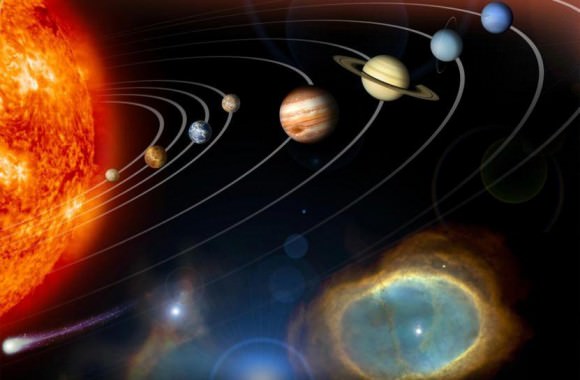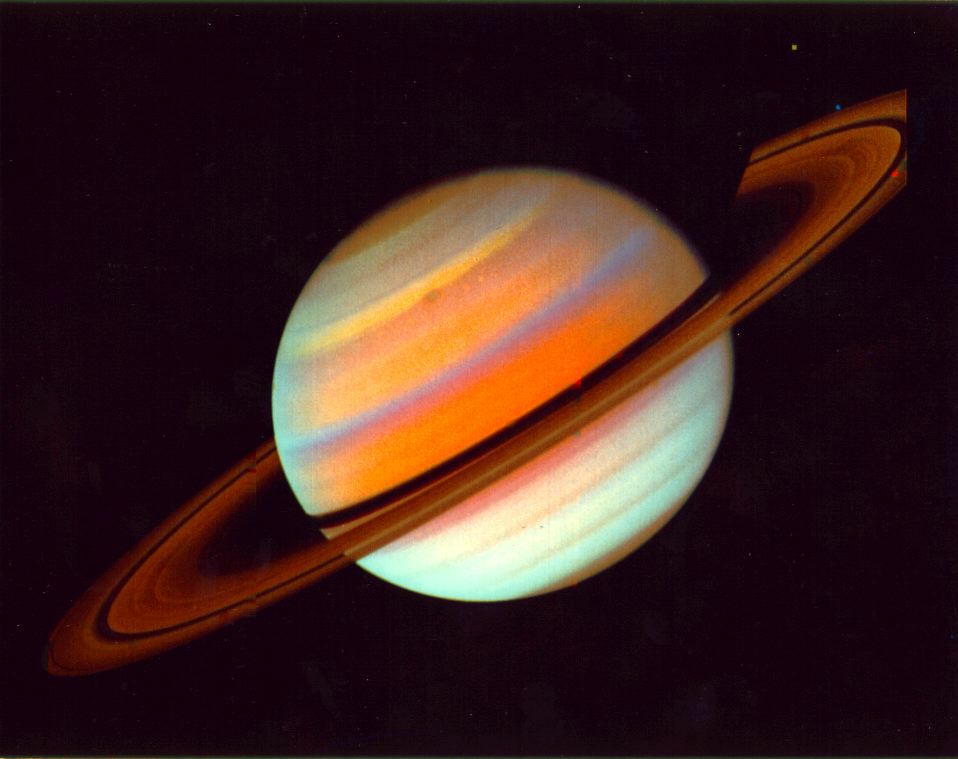Our solar system is composed of nine planets. These planets are categorized into two. First is the Inner Solar System. Inner Solar System is composed of the four inner planets- Mercury, Venus, Earth and Mars. These are made up mostly of iron and rock. They are known as terrestrial or earth like planets because of their similar is the Outer Solar System, which is composed of the outer planets- Jupiter, Saturn, Uranus and Neptune. They are giant worlds with thick outer layers of gas. Nearly all their mass is made up of helium giving them composition like that of the sun. Beneath these outer layers, they have no solid surfaces. The pressure from their thick atmosphere liquefy their insides, although they might have rocky cores.

Now let us start to explore and know deeper about the different planets in the solar system. As you roam outward from the sun, Mercury is the closest planet. It orbits the Sun at an average distance of 58km. This planet is airless, and so without any essential atmosphere to hold in the heat, it has climactic differences. The side that faces the Sun experiences temperature as high as 420Â degrees Celsius. while the side in the shadow goes down to -137Â degrees Celsius. It is also the smallest planet in the Solar system., measuring only 4879km across its equator.

Venus. It is the 2nd planet in the Solar System that orbits at an average distance of 108km, and completes its orbit around the sun every 224 days. It's an almost twin of Earth in terms of size and mass. But, Venus vary to that of the Earth in terms of its temperature. It has extremely thick atmosphere which made almost entirely of carbon dioxide that cloaks the planet and helps it to heat up to 460Â degrees Celsius. The surface of Venus is 92 times the pressure of Earth's atmosphere. In fact the spacecraft that landed here only survived a few hours.

Earth.It is the only planet in the Solar System known t support life. It orbits the Sun at an average distance of 150,million km. Our atmosphere keeps the planet warm from the vacuum space, but not so thick that we have a runaway greenhouse effect. The Earth has a solid core of iron surrounded by a liquid outer core that generates a magnetic field that also helps protect life on Earth from the radiation of space. It has only a single moon.

Mars. Is the second smallest planet in the Solar System. It orbits the Sun at a distance of 228 million km. The surface of Mars has only 1/3rd of Earth's gravity. It has almost no atmosphere to help trap heat from the Sun, and so temperature can plunge below -140 Â degrees Celsius in the Martian winter. On summer, temperature can get up to 20Â degrees Celsius in the day. It has two tiny asteroid-sized moons: Phobos and Deimos. Between the orbits of Mars and Jupiter lies the asteroid belt, which includes the dwarf planet Ceres.

Jupiter. Is the biggest planet in our Solar System. It's so large, in fact it has 2.5 times the mass of all the rest of the planets in the Solar System is combined. Jupiter orbits the Sun at an average distance of 779 million km. It is almost entirely made up of hydrogen and helium. It has 63 moons that made it the planet with most moons in the Solar System. Cassini and New Horizons are the spacecraft that visited here more recently.

Saturn. The second largest planet in our Solar System. It orbits the Sun at an average distance of 1.4 billion km. Saturn has much less mass that as a matter of fact, Saturn will float in a large enough pool. The most amazing feature of Saturn is it's rings. These are made up of particles of ice ranging from size of a sand to the size of a car. It is believed that it's rings are only a few hundred million years old, while others think they could be as old as the Solar System, and it has a total of 60 moons. discovered so far.

Uranus. The seventh planet from the Sun. It orbits at an average of 2.9 billion km. It is the third largest planet in the Solar System. Uranus was the first planet to be discovered with a telescope which is first recognized as a planet in 1781 by William Herschel. The Voyager 2 is the only spacecraft ever visited Uranus up close. Uranus has 27 moons.

This beautiful picture of Uranus might look like it was captured by a space telescope, but it was actually taken from the powerful Keck telescope located on Hawaii’s Mauna Kea. This image shows Uranus in the infrared spectrum, which reveals the detailed cloud patterns in the atmosphere of the planet.
Neptune. Is the eight and final planet in the Solar System, orbiting at an average distance of 4.5 billion km from the Sun. It's the fourth largest planet. It is 3.8 times larger than Earth. Neptune is the second planet discovered in modern times. It is discovered by both Urbain Le Verrier and John Couch Adams. It has 13 moons.

This is a classic picture of Neptune captured by NASA’s Voyager 2 spacecraft during its 1989 flyby of Neptune. The NASA spacecraft had already visited Jupiter, Saturn and Uranus during its trip, and Neptune was the final stop on its grand tour of the planets before speeding off into deep space. You can see a giant storm raging on the surface of Neptune, which scientists have named Neptune’s Great Dark Spot.
Beyond the orbit of Neptune, one finds the disk-shaped Kuiper belt, in which dwarf planet Pluto resides and far beyond that, is the giant, spherical Oort cloud and the teardrop-shaped heliopause.

Now let us start to explore and know deeper about the different planets in the solar system. As you roam outward from the sun, Mercury is the closest planet. It orbits the Sun at an average distance of 58km. This planet is airless, and so without any essential atmosphere to hold in the heat, it has climactic differences. The side that faces the Sun experiences temperature as high as 420Â degrees Celsius. while the side in the shadow goes down to -137Â degrees Celsius. It is also the smallest planet in the Solar system., measuring only 4879km across its equator.

Venus. It is the 2nd planet in the Solar System that orbits at an average distance of 108km, and completes its orbit around the sun every 224 days. It's an almost twin of Earth in terms of size and mass. But, Venus vary to that of the Earth in terms of its temperature. It has extremely thick atmosphere which made almost entirely of carbon dioxide that cloaks the planet and helps it to heat up to 460Â degrees Celsius. The surface of Venus is 92 times the pressure of Earth's atmosphere. In fact the spacecraft that landed here only survived a few hours.

Earth.It is the only planet in the Solar System known t support life. It orbits the Sun at an average distance of 150,million km. Our atmosphere keeps the planet warm from the vacuum space, but not so thick that we have a runaway greenhouse effect. The Earth has a solid core of iron surrounded by a liquid outer core that generates a magnetic field that also helps protect life on Earth from the radiation of space. It has only a single moon.

Mars. Is the second smallest planet in the Solar System. It orbits the Sun at a distance of 228 million km. The surface of Mars has only 1/3rd of Earth's gravity. It has almost no atmosphere to help trap heat from the Sun, and so temperature can plunge below -140 Â degrees Celsius in the Martian winter. On summer, temperature can get up to 20Â degrees Celsius in the day. It has two tiny asteroid-sized moons: Phobos and Deimos. Between the orbits of Mars and Jupiter lies the asteroid belt, which includes the dwarf planet Ceres.

Jupiter. Is the biggest planet in our Solar System. It's so large, in fact it has 2.5 times the mass of all the rest of the planets in the Solar System is combined. Jupiter orbits the Sun at an average distance of 779 million km. It is almost entirely made up of hydrogen and helium. It has 63 moons that made it the planet with most moons in the Solar System. Cassini and New Horizons are the spacecraft that visited here more recently.

Saturn. The second largest planet in our Solar System. It orbits the Sun at an average distance of 1.4 billion km. Saturn has much less mass that as a matter of fact, Saturn will float in a large enough pool. The most amazing feature of Saturn is it's rings. These are made up of particles of ice ranging from size of a sand to the size of a car. It is believed that it's rings are only a few hundred million years old, while others think they could be as old as the Solar System, and it has a total of 60 moons. discovered so far.

Uranus. The seventh planet from the Sun. It orbits at an average of 2.9 billion km. It is the third largest planet in the Solar System. Uranus was the first planet to be discovered with a telescope which is first recognized as a planet in 1781 by William Herschel. The Voyager 2 is the only spacecraft ever visited Uranus up close. Uranus has 27 moons.

This beautiful picture of Uranus might look like it was captured by a space telescope, but it was actually taken from the powerful Keck telescope located on Hawaii’s Mauna Kea. This image shows Uranus in the infrared spectrum, which reveals the detailed cloud patterns in the atmosphere of the planet.
Neptune. Is the eight and final planet in the Solar System, orbiting at an average distance of 4.5 billion km from the Sun. It's the fourth largest planet. It is 3.8 times larger than Earth. Neptune is the second planet discovered in modern times. It is discovered by both Urbain Le Verrier and John Couch Adams. It has 13 moons.

This is a classic picture of Neptune captured by NASA’s Voyager 2 spacecraft during its 1989 flyby of Neptune. The NASA spacecraft had already visited Jupiter, Saturn and Uranus during its trip, and Neptune was the final stop on its grand tour of the planets before speeding off into deep space. You can see a giant storm raging on the surface of Neptune, which scientists have named Neptune’s Great Dark Spot.
Beyond the orbit of Neptune, one finds the disk-shaped Kuiper belt, in which dwarf planet Pluto resides and far beyond that, is the giant, spherical Oort cloud and the teardrop-shaped heliopause.
Pluto is not considered a planet anymore.
image of pluto
.. and that ends our journey to the different planets in the Solar System ..


Thank you for sharing the Journey Towards the Solar System
ReplyDeleteAlso read Fun Facts about the number 9